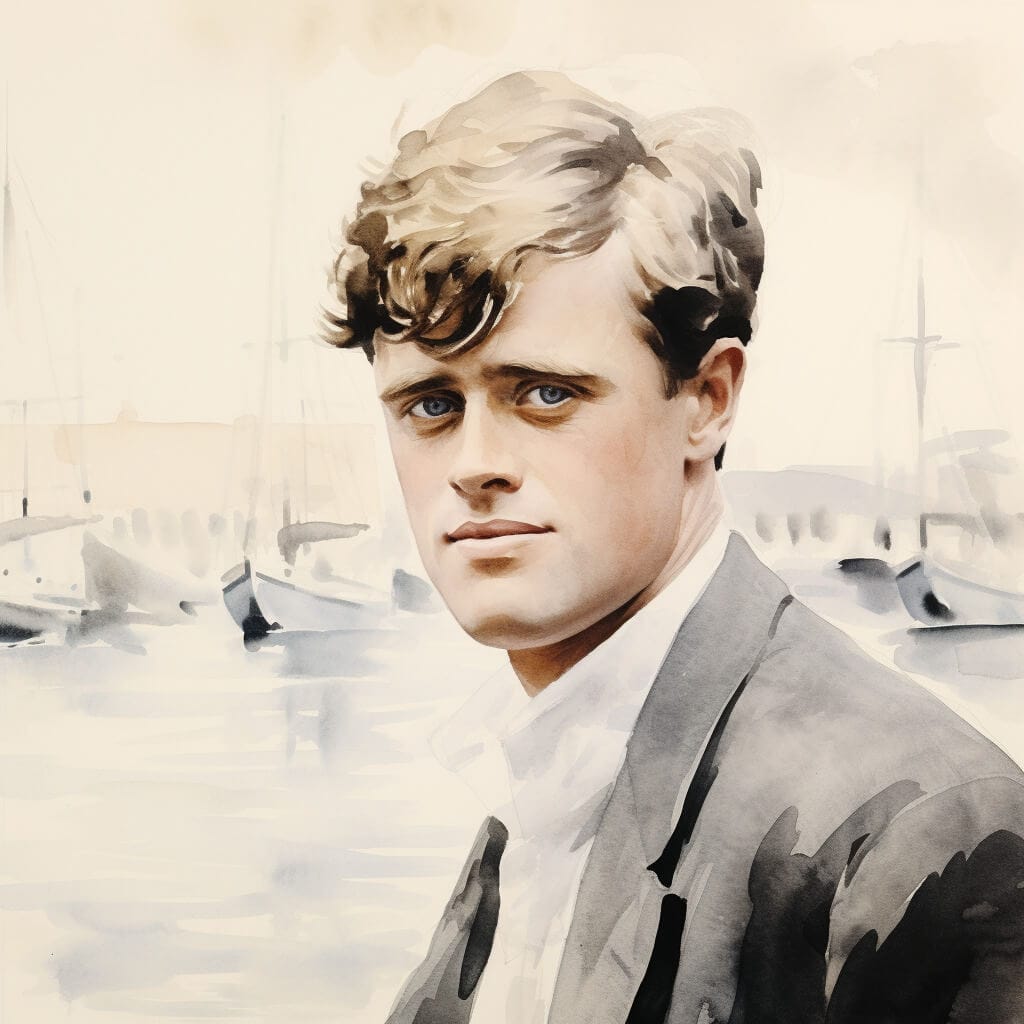Top Questions
Jack London was born in January of 1876 in San Francisco, California, as John Griffith Chaney. He had a tough upbringing, which ultimately contributed to his adventurous life and stories.
Jack London’s poetry was not widely recognized despite creating some excellently crafted poems. His fame and success primarily come from his work as a novelist and short story writer.
Jack London was influenced by a variety of writers and thinkers, including Rudyard Kipling, Karl Marx, Charles Darwin, and Friedrich Nietzsche. Their ideas on adventure, social conditions, evolution, and philosophy profoundly shaped his worldview and writings.
Jack London died of uremia, complicated by gastrointestinal uremic poisoning, on November 22, 1916, at his ranch in Glen Ellen, California. His health had been deteriorating due to various medical conditions.
Jack London was an American novelist, journalist, and activist who became synonymous with adventure. Throughout his life, he was linked with California and the Klondike gold rush. He was such a prolific writer that, over the course of his last 16 years, he published over 50 books, from novels to poetry collections. Some of his most well-known books include the likes of The Call of the Wild, White Fang, The People of the Abyss, The Road, John Barleycorn, and the autobiographical novel Martin Eden. He is now considered to be one of the most translated American authors of the 20th century.
Early Life
Jack London was born John Griffith Chaney in San Francisco, California, in January of 1876. While it is unclear who exactly London’s father was, he was likely William Chaney, an astrologer. It was around Chaney’s hometown of San Francisco that London’s mother, Flora Wellman, became pregnant. It is unknown whether or not the couple ever married.
Jack London’s life was filled with difficulties before he was born, as accounted for by Flora. She attempted to kill herself after Chaney refused to help her with the child and demanded she get an abortion. She was not seriously injured but became mentally unstable after the episode. After giving birth to the boy, she turned him over to be cared for by Virginia Prentiss, who was a former slave. She was the main maternal figure in London’s early life.
In 1876, soon after London’s birth, Flora married John London who was a Civil War veteran. The new family eventually settled in Oakland, where London attended grade school. London made the call to leave school at 14 years of age. The reason for this was to pursue a life of exploration and adventure. San Francisco Bay became his stomping ground, where he alternated between stealing oysters and working for various government-run fish patrols.
One of these jobs was at Hickmott’s Cannery in an attempt to make enough money to leave the area. In 1893, he became a sailor when he signed onto the schooner Sophie Sutherland, which sailed to Japan. After returning, he finished four years of high school in one year. His first published work was Typhoon of the Coast of Japan, which told of his sailing experiences. He also had a spell exploring the United States as a hobo riding freight trains.
The story of how Typhoon of the Coast of Japan was an interesting one. At the age of 17, he came head to head with a powerful typhoon, which nearly killed him. After this traumatic and exhilarating experience, he told his mother when he came home. Around the same time, there was a writing contest that his mother became aware of. Encouraging him to enter, he heeded her advice, and he won the $25 winning prize. When he won ahead of well-educated Stanford and Berkeley, it gave him the confidence that he was talented despite his limited early education.
When he was twenty-one, he entered the University of California, Berkeley. It was while he was enrolled there that he found out about the tumultuous events around his birth. The young man reached out to William Chaney through writing. Chaney responded harshly, claiming he couldn’t be the boy’s father. This rebuke devastated London, and he soon quit school and moved to Klondike during the gold rush, in the search for a fortune. Due to his experiences of poverty and of those around him, he built a political leaning towards socialism.
While in Klondike, Jack London wrote prolifically—but his health suffered. He developed scurvy, and his gums swelled until he lost his four front teeth. He also suffered from pains in his hip and leg muscles. It was in 1898 that London became serious about getting published. He saw his writing as a way of escape from poverty. His first piece published since high school was “To the Man on Trail.” It is still included in many anthologies of London’s works. It was also around this period of time that he published other short stories such as A Klondike Christmas, Mahatma’s Little Joke and O Haru.
Writing Success
By 1900, he was making a good living off his writing, somewhere in the range of $75,000 a year in today’s currency. At one point, he was one of, if not the, most well-paid writer in the United States. Despite this incredible feat, it was never enough for him, due to his always increasing expenditure.
These years also saw London marry Elizabeth Maddern. Their marriage was not one of love but of friendship, consummated with the intent of producing strong children. Although both were clear about the arrangement, the marriage was still strained. They divorced only four years later (in 1904) after having two daughters.
It was not until 1902 that his first novel, The Cruise of the Dazzler, was published. It was quickly followed by A Daughter of the Snows and then his seminal work, The Call of the Wild, in 1903. It became a quick success. London moved around during these years, settling for a time in a home near Piedmont.
In 1904, Jack London went to work for Hearst Papers, where he began covering the Russo-Japanese War as a war correspondent, but had to return after he was threatened with a court martial for knocking out a Japanese officer. He also focused on works surrounding Hawaii surfing and brought the discussions around capitalism to the readers. He traveled to Yokohama, where he was arrested and later released after intervention from the American ambassador. He was arrested once more in Korea after traveling too close to the border. London was arrested for the third time after being accused of stealing fodder for his horse.
A year after his divorce, he married Charmian Kittredge. The two were very well-suited and spoken of as “soulmates” by close friends. The couple moved to a ranch in Glen Ellen, Sonoma County. They worked the land for a number of years, but the venture did not succeed. Some suggest its failure was due to London’s own bad management or his burgeoning alcoholism. In 1911, he took the challenge of sailing in the South Pacific, which became the basis of the stories told in The Cruise of the Snark.
Later Life and Death
It was on November 22, 1916, while sleeping on the porch of his cottage in Glen Ellen, California, that London died. He had suffered all his life from a variety of illnesses, many brought on by the scurvy of the Klondike days. There were also unspecified infections contracted while traveling in the tropics. By the time of his death, he was known to be deeply impaired due to alcoholism and uremia. He was also taking a great deal of morphine for his pain.
Jack London was buried on his property, close to Wolf House, a structure he spent a great deal of money building. There has been some discussion since his death that it was not accidental but instead a successful suicide via morphine overdose. The Jack London State Historic Park is now part of his legacy and was the home where he died.


